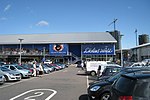Chattenden and Upnor Railway
18 in gauge railways in England2 ft 6 in gauge railways in EnglandMilitary railways in the United KingdomRail transport in KentTransport in Medway ... and 1 more
Use British English from March 2017

The Chattenden and Upnor Railway (also known as the Lodge Hill and Upnor Railway) was a narrow gauge railway serving the military barracks and depot at Upnor, Kent and associated munitions and training depots. It started life in the early 1870s as a standard-gauge railway. The 2 ft 6 in (762 mm) narrow gauge working began in 1885, initially in a mixed gauge formation with the standard gauge, and post circa 1903 2 ft. 6 in. gauge exclusively. In the latter form the line continued in use until the end of 1961.
Excerpt from the Wikipedia article Chattenden and Upnor Railway (License: CC BY-SA 3.0, Authors, Images).Chattenden and Upnor Railway
Broadwood Road,
Geographical coordinates (GPS) Address Nearby Places Show on map
Geographical coordinates (GPS)
| Latitude | Longitude |
|---|---|
| N 51.418 ° | E 0.53 ° |
Address
Broadwood Road
Broadwood Road
ME3 8LU , Hoo St. Werburgh
England, United Kingdom
Open on Google Maps










